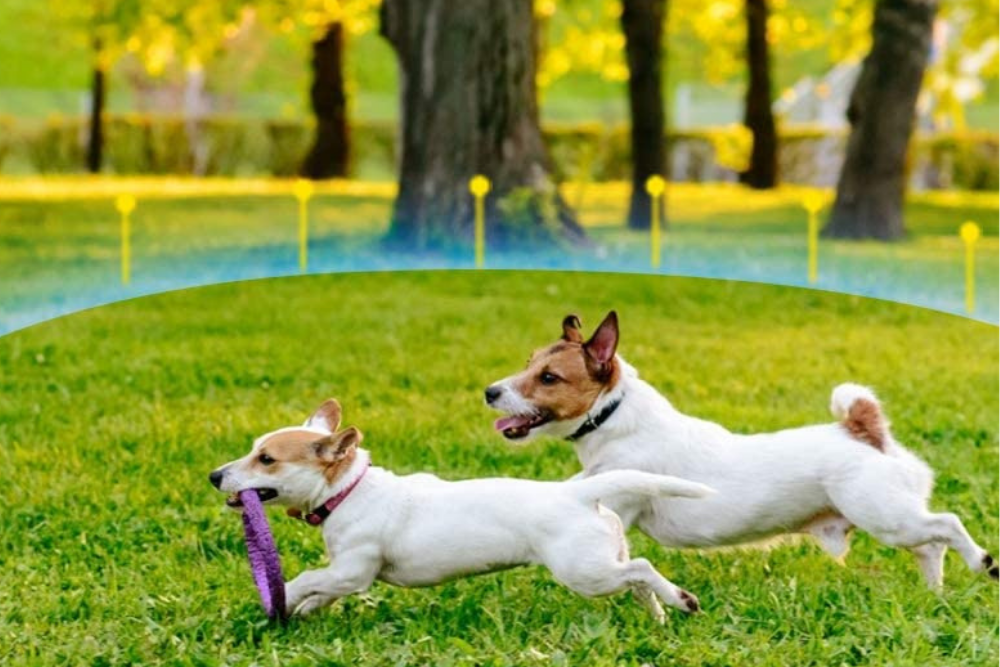How Does Underground Dog Fence Work

An underground dog fence, also known as an invisible fence, is a type of pet containment system that provides an alternative to traditional physical fences. This wireless system consists of a transmitter that connects to a boundary wire buried underground around the perimeter of an assigned area and a receiver collar worn by the dog. When the dog approaches the boundary, the collar emits a warning beep, followed by a static correction if it attempts to cross the boundary. The level of correction can be adjusted according to the pet’s size, temperament, and prey drive. Proper training is crucial for the success of this system.
Types of Underground Dog Fences
If you’re looking for a way to keep your dog confined to your yard without having to rely on a physical barrier, you may be considering an underground dog fence. These systems offer a range of benefits, such as being virtually invisible and customizable to your yard’s specific layout and size. However, there are also different types of underground dog fences available in the market, and it’s important to understand the differences between them to make an informed decision.
The two main types of underground dog fences are wired and wireless. Wired fences require the installation of a physical boundary wire, which is buried underground around the perimeter of your yard. The wire sends a signal to a receiver collar that your dog wears, emitting a warning beep when the dog approaches the boundary and delivering a mild static correction if the dog attempts to cross it. In-ground wired fences are a type of wired fence that requires a bit more work to install, as you’ll need to dig a trench to bury the wire. However, in-ground wires tend to be more durable and reliable than fully wireless systems.
Wireless fences, on the other hand, are completely wire-free and rely on radio signals to create a circular boundary around a transmitter. These systems are easier to set up and can be more convenient if you’re looking for a portable option. However, wireless fences are less customizable than wired fences, and their signal can be affected by terrain, metal objects, and other interference. Fully wireless fences are the most common form of wireless fences, but there are also semi-wireless options that use a combination of wired and wireless components.
It’s also important to note that some underground dog fences can accommodate multiple dogs within the same system, while others cannot. If you have more than one dog, make sure to choose a fence that allows for multiple receiver collars to be used simultaneously.
Underground Dog Fence
An underground dog fence is a popular way to keep your pet contained within your property without having to resort to physical barriers such as traditional fences. The fence typically uses a combination of a buried boundary wire, a receiver collar, and a transmitter to create an invisible boundary that your dog cannot pass. In this article, we’ll take a closer look at how underground dog fences work and the different types available on the market.

What Is a Radio Signal?
A radio signal is a type of electromagnetic wave that is used to transmit information through the air. In the context of underground dog fences, radio signals are critical components that help to create a virtual boundary for the dog. These signals are transmitted by the boundary wires that are installed around the perimeter of the containment area, and picked up by the receiver collar that is worn by the dog.
The radio signal serves to encircle the containment area, creating a boundary for the dog to avoid crossing. When the dog approaches the boundary, it receives a warning beep or tone, which is a signal for the dog to turn back. If the dog continues to move toward the boundary, it will receive a static correction that is designed to discourage it from crossing the boundary.
Adjusting the strength of the radio signal is an important aspect of using underground dog fences. By adjusting the strength of the signal, you can customize the containment area to suit the size of your property. This can help to prevent the dog from wandering too far from home, or from getting into trouble on neighboring property.
Radio signals used for invisible fencing typically operate on pre-set frequencies, which limits interference from other devices. This means that your underground dog fence will work effectively even if there are other electronic devices nearby. It is important to choose a frequency that is compatible with your transmitter box and receiver collar to ensure that your system operates correctly.
What Is a Boundary Wire?
A boundary wire is a critical component of an underground dog fence system. Its primary function is to emit a radio signal that communicates with the receiver collar worn by the dog. This signal serves as a virtual boundary that alerts the dog when it approaches the perimeter of the containment area and triggers a stimulus designed to discourage it from crossing the boundary.
To set up the boundary wire, it must be connected to the transmitter box, which is usually located inside the home. The transmitter box sends a continuous signal through the boundary wire, and the receiver collar picks up this signal when the dog approaches the boundary. The collar is designed to emit a warning beep or tone at first, followed by a static correction only if the dog continues to move closer toward the boundary.
Installing and burying the boundary wire is a crucial step in setting up the underground dog fence system. The wire can be customized to fit the shape of the desired containment area, allowing pet owners to exclude certain parts of their property from their dog’s access. This feature makes underground dog fences an attractive option for pet owners who want to allow their dogs to roam freely and safely within designated boundaries.
To install the boundary wire, pet owners should use the provided stakes and flags to mark the perimeter of the containment area. Then, the wire should be looped around the perimeter and buried 1 to 3 inches underground. It is important to ensure that the wire is secured tightly to the ground so that it can emit a consistent radio signal.
One aspect of boundary wire installation that may require additional attention is the neutralization of the radio signal at the gate passage. To achieve this, pet owners can twist two sections of boundary wire together, effectively canceling out the radio signal in that area. This technique enables the dog to pass through the gate without receiving a static correction.
How Does the Receiver Collar Work?
The receiver collar is a vital component of the underground dog fence system. It is worn by the dog and is usually adjustable to fit comfortably around the neck. The collar contains a receiver that picks up the radio signal transmitted by the boundary wire through the dog’s movement around the containment area.
One significant aspect of the receiver collar is its customization of correction levels. Depending on the individual temperament of the dog, the collar can be adjusted to emit the appropriate level of static correction to deter the dog from crossing the boundary. Pets with a high prey drive or stubborn nature may require a higher level of correction, while more docile pets may need only a slight correction to obey the boundary.
Before releasing the dog, it is important to test the receiver collar to ensure it is working correctly. Testing primarily involves walking with the collar around the boundary and encouraging the dog toward the wired fence. When the dog reaches the boundary, the collar should emit a warning beep to alert it that it is getting close to the limit of the designated area. If the dog ignores the warning beep and keeps approaching the boundary wire, the collar will emit a mild static shock to deter it from continuing.
The warning beep is important because it gives the dog time to learn and understand that there is a boundary in place. This learning process will ultimately reduce the need for the use of static shock, and it will encourage the dog to stay within the designated boundaries. Over time, the dog will learn to respond to the warning beep and eventually avoid crossing the boundary.
Regular testing of the receiver collar and transmitter is necessary to ensure consistent functionality. You should check the batteries and ensure that they are fully charged with a rechargeable battery or replaced with new ones in case of a dead battery. Also, make sure that the collar fits properly and is not causing any skin irritation or discomfort to the dog.
In case of any adjustments, always use the collar’s user manual for specific instructions on modification as each collar has its own specifications and sensitivity settings. By using the right adjustments, you can customize the underground dog fence system to fit the unique needs of your pet while keeping them safe within the designated boundaries.
How to Do Warnings and Static Corrections Work?
Underground dog fences are a humane and effective way to contain pets within a designated area. One of the key components of such systems is the use of warnings and static corrections to train the dog to stay within the boundaries.
The warning signal is usually emitted via an audible tone or beep that alerts the dog that it is getting too close to the boundary. This tone-only mode helps the dog learn and associate the sound with the boundary. Over time, the dog learns to retreat when it hears this tone and eventually stays within the boundary without the need for static corrections.
The trigger zone refers to the area between the warning line and the boundary line where the static correction is triggered. When the pet enters this zone, it experiences a static correction that is tailored to its temperament. The adjustment levels are customizable to suit each pet’s temperament. As a general rule, pets with a high prey drive or stubborn nature require higher levels of correction. In contrast, more docile pets may need only a slight correction to obey the boundary.
There are different types of special collars available in the market that emit stronger static corrections when compared to the standard collar. Some collars emit citronella spray that creates an unpleasant experience for the dog, thus preventing it from crossing the boundary. These collars are specifically designed for pets with low pain tolerance or for pet owners who prefer humane options.
Can You Train Your Dog to Use an Underground Fence?
Training your dog to use an underground fence is a great way to provide them with the freedom to roam and explore while keeping them safely contained on your property. However, it is essential to ensure that your dog is physically healthy and at least 8 weeks old before starting any training session.
The first step in training your dog to use an underground fence is to introduce them to the boundaries and the warning beep. Show them where the boundary lines are marked and let them hear the warning beep. This will help them learn and associate the sound with the designated area.
Next, use flags to mark the boundaries and allow the dog to explore the area on a leash. This will help them understand the designated area and become familiar with the boundary. During this time, pay close attention to their reaction to the warning beep and how they behave when they are near the boundary.
Gradually increase the length of time and distance of where the dog can explore within the designated area. Remember to keep the training sessions short and use positive reinforcement such as treats and praises to encourage good behavior.
Over time, your dog will become more confident staying within the designated area and respond less to the warning beep. It is important to remember that each dog has their temperament, and some dogs may require more training sessions than others.
Pros of Underground Dog Fences
Underground dog fence have become a popular and effective solution for dog owners who want to ensure the safety of their pets while still allowing them to enjoy their freedom. These fences work by using a receiver collar that picks up signals from a transmitter box and responds with a warning beep or static correction when the dog approaches the boundaries. In this article, we will discuss some of the pros of using an underground dog fence for your furry friend.
Pros of Using an Underground Dog Fence
Underground dog fences are an innovative and effective way to keep dogs safe within a designated area while allowing them the freedom to run and play. The system is composed of several key components, including a transmitter box, boundary wires, and a receiver collar worn by the dog.
The boundary wires emit a low-level radio signal that establishes the perimeter of the designated area. The signal is picked up by the receiver collar worn by the dog. When the dog gets too close to the boundary, the collar emits a warning beep. If the dog continues to approach the boundary, the collar administers a static correction to discourage the dog from crossing it.
Moreover, underground dog fences are customizable, which means pet owners can create exclusion zones within the perimeter that the dog should not enter. This feature gives the owner complete control over their pet’s movements, which is particularly useful in preventing them from accessing areas that may be dangerous or harmful.
There are several advantages to using an underground dog fence system. For one, it is a safe and effective method for containing dogs within a designated area, especially if the dogs have a high prey drive or are known escape artists. This is particularly useful for pet owners who live near busy roads or have unpredictable wild animals in their area.
Another advantage of underground dog fences is that they are cost-effective and easy to install. Instead of the higher cost and maintenance of a traditional physical fence or chain link fence, pet owners can set up the system themselves or hire a professional for installation, which is much less of a hassle.
Additionally, unlike traditional fences, underground dog fences do not obstruct the view and allow for an uninterrupted scenic view. They require minimal maintenance and do not require the replacement of batteries frequently.
Overall, an underground dog fence system provides a beneficial and effective way to control your dog’s movements and keep them safe within a designated area, all while being cost-effective, customizable, and requiring little-to-no maintenance.
Alternatives to Underground Dog Fences
Underground dog fences are a popular choice for pet owners looking for a safe and effective containment system. However, there are alternatives available for those who are not comfortable with using this type of system for their pets. In this article, we will explore some of the alternatives to underground dog fences, how they work, and their benefits and drawbacks.

Traditional Physical Barriers, Including Chain Links and Wooden Fences.
Traditional physical barriers, such as chain links and wooden fences, have been popular options to contain dogs for years. However, with advancements in technology, underground dog fences have gained popularity in recent years as a viable alternative.
The primary benefit of traditional fences is their physical presence, which provides a clear and visible boundary for both dogs and humans. Chain link fences are particularly popular for their durability and strength, making them a great choice for larger dogs. Likewise, wooden fences offer a more natural look and can be customized to meet a homeowner’s aesthetic preferences.
However, traditional fences come with drawbacks that must be considered. The level of containment provided by a physical fence can vary depending on the size, strength, and training of a dog. Additionally, traditional fences can be expensive, and depending on their height and the materials used, they may require maintenance over time.
Contrastingly, underground dog fences offer several advantages over traditional fences. For instance, invisible fences typically cost less than their traditional counterparts, making them an attractive choice for dog owners. Additionally, invisible fences are a great option for homeowners who are not permitted by their local municipalities to construct traditional fences.
However, underground dog fences require special collars and receivers, which emit a static correction after detecting a radio signal from the boundary wires buried underground. While effective, some dog trainers and animal behaviorists criticize this method for its use of electric shocks and the potential harm it can cause to a dog’s mental and emotional state.
Electronic or Electric invisible fences
Electronic or electric invisible fences are a type of containment system used to keep dogs within a set boundary. These fences differ from traditional fences in that they use a radio signal and a receiver collar to create the boundary line instead of physical barriers.
Unlike electric livestock fences which are designed to keep animals out of an area, electronic invisible fences are designed to keep dogs within a certain area. These fences are used to prevent dogs from roaming away from a property, digging up gardens, or entering certain areas of a property.
An invisible fence system comprises three main components: hidden boundary wires, a transmitter, and a receiver collar. The boundary wires are buried underground, creating an invisible perimeter around the area that the dog is allowed to access. The transmitter sends a radio signal through the boundary wires, while the receiver collar picks up the signal.
When a dog approaches the boundary line, the receiver collar emits a warning signal. This warning sound is intended to train the dog to stop and turn back without getting a static shock. If the dog ignores the warning signal and crosses the boundary line, the collar emits a static correction, which is typically a safe and mild electric shock.
The level of correction can be adjusted depending on the size of the dog and its tendency to stray. Some systems also include multiple levels of correction to gradually train dogs to stay within the boundary zones.
Other Methods for Containing Your Dogs, Such as Invisible Leash Systems.
While invisible fences are a popular choice for pet owners who want to keep their dogs contained in a certain area, there are several other options available. One of these options is an invisible leash system, which offers a different kind of virtual fence.
An invisible leash system comprises a small, portable device that attaches to your dog’s collar and emits a signal that only they can hear. The device acts as a virtual leash, keeping your dog within a certain distance of the device. With this system, you do not need to worry about burying any wires or installing a transmitter.
Invisible leashes are especially useful for traveling with your pet or taking them on walks where a traditional leash may not be possible or practical. They also provide an additional layer of protection for dogs who may easily slip out of a collar or harness.
Another method of containing your dog is through the use of tie-out stakes or tethers. These can be used in conjunction with a physical fence or on their own. A tie-out stake is driven into the ground, while a tether is attached to a fixed point such as a tree or post. These methods allow your dog more freedom than a physical fence but must be used with caution to ensure that your pet does not become tangled or injured.
Indoor enclosures such as pet gates or playpens are another option for containing your dogs. These enclosures provide a safe space for your dog to play, eat, and rest while keeping them out of restricted areas of your home. Additionally, these enclosures are portable and can be used both indoors and outdoors.
While invisible fences remain a popular choice, these alternatives for containing your dogs provide greater flexibility and variety depending on your specific needs and circumstances. Consider your personal preferences and your dog’s temperament when selecting the best method for containing your pet.
Conclusion
In conclusion, it is crucial to carefully consider both the pros and cons before deciding to use an underground dog fence. While it can be an effective way of containing your furry friend, it does come with its own set of challenges and limitations.













